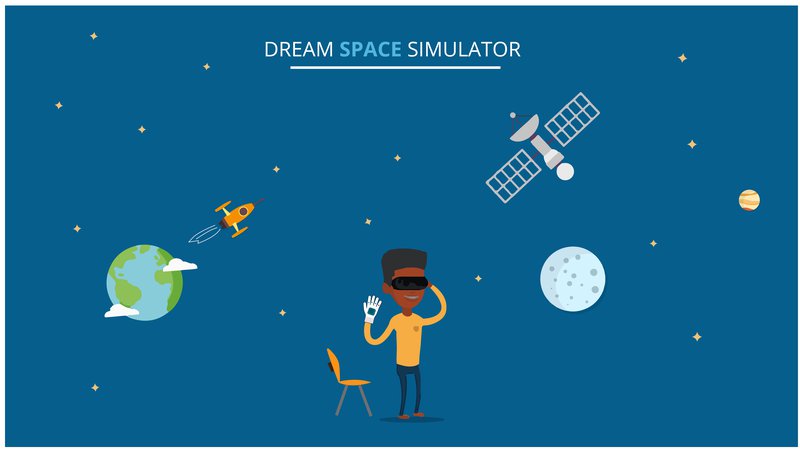Kepler | Space Jockey
Awards & Nominations
Kepler has received the following awards and nominations. Way to go!
The Challenge | Space Jockey
DREAM SPACE SIMULATOR
This project is aimed at providing an experience of travelling to space in an interactive and educational manner.

DREAM SPACE SIMULATOR
MODULE 1:
THE VIRTUAL REALITY SIMULATOR
Components used:
- Dream VR (wearable)
- Android phone/iOS phone
Software used:
- Unity 5.6
- Google cardboard SDK
- Maya
Working:
The 3D models have been created and rigged using MAYA. We tried to keep the cockpit model as realistic as possible. The models were integrated in UNITY and proper rules of association were enforced so that the models interact as a unit. The Unity created app receives instructions in form of JSON format which are decoded in C#.
MODULE 2:
DYNAMIC ORIENTATION CHANGING CHAIR
Components used:
- Vibration motor(6V)
- Servo (15kgcm)
- Arduino uno
Software used:
- Arduino IDE
The chair has two modules:
- 1)Vibration module
- 2)Orientation module
Both the modules are connected by a single Arduino which receives instructions from AI BOT.
Vibration module: The bottom of the chair is rigged with 3 vibration motors which are power up while interacting in the virtual reality. During the launch sequence the three motors work synchronously to provide the maximum vibrations while during interaction they respond depending on the directional events in the virtual reality.
Orientation module: the orientation of the chair is changed during the launch sequence. The back support is pulled to provide a more up-facing view to give a feel of acceleration during a real launch.
MODULE 3:
THE GLOVE
Components used:
- Arduino uno
- HC-05 Bluetooth module
- MPU6050 module
- IR module
Softwares used:
- Arduino IDE
Documentation of the Glove Gesture recognition has always be a pain for developers. There are two solution presently available for gesture recognition, image processing and through some hardware in form of glove or band. The problem with image processing is that a person always need a view of camera at his hand for getting the image. And when it comes to hardware gloves or bands, the problem with these gadgets is that they are too costly. We decided to design our own gloves to bring down the cost. The main reason of high costing of these gadgets is high cost of sensors which are used in this. Therefore we designed our own sensors. We used most trivial laws of physics that as light goes through multiple reflections its intensity reduces. We took 2m of transparent plastic pipe and cut it into pieces according to length of fingers and then were wrapped with electric tape to reduce the loss of light. Then we attached a IR emitter and receiver at two ends and observed as the pipe was bent the intensity reduces which we measured using an android. Then we used MPU6050 sensor to get the alignment of hand. And using the data from these sensors we were able to gesture as well as complete orientation of the hand. Then we used HC-05 (Bluetooth module) to send the data to mobile. Ultimately we were able to bring the cost of complete gesture recognition glove under $25. Components used: Arduino Uno HC-05 MPU6050 IR Module ESP8266
MODULE 4:
ARTIFICIAL INTELEGENT ASSISTANT
Hardware and Equipment used:
- GSM module
- Arduino uno
- BlueTooth-HC05 module
- 4 channel 12V 10A relay control board module with optocoupler for PIC AVR ARM
Programming Platforms
- For programming the Arduino uno, we have used the default Arduino IDE.
- We have developed our Android app using Android Studio (JAVA and XML).
- Database connectivity is done using Google's Firebase.
- For augmented reality we have used Unity along with the Vuforia SDK.
Implementation:
- All the components are giving readings to the Arduino, where we are converting these readings into character code in order to send the bytes efficiently and quickly to the computer. Inside a never ending loop, every reading corresponds to a character.
- A code should run on the computer in order to receive the data that is being sent by arduino via serial ports.
- For developing the android app we are using android studio and to convert voice to text we are using the standard google api.
- For speech recognition we are using acoustic-phonetic speech parameters for speaker-independent speech recognition in the android app.
- We have the AI (artificial intelligence) virtual assistant which uses deep learning techniques like CNN (Convolutional Neural Network) using python to implement the natural language processing.
- For the augmented reality app we are using Unity IDE and Vuforia SDK (It is an Augmented Reality Software Developments Kit (SDK) for mobile devices that enables the creation of Augmented Reality applications).
SpaceApps is a NASA incubator innovation program.